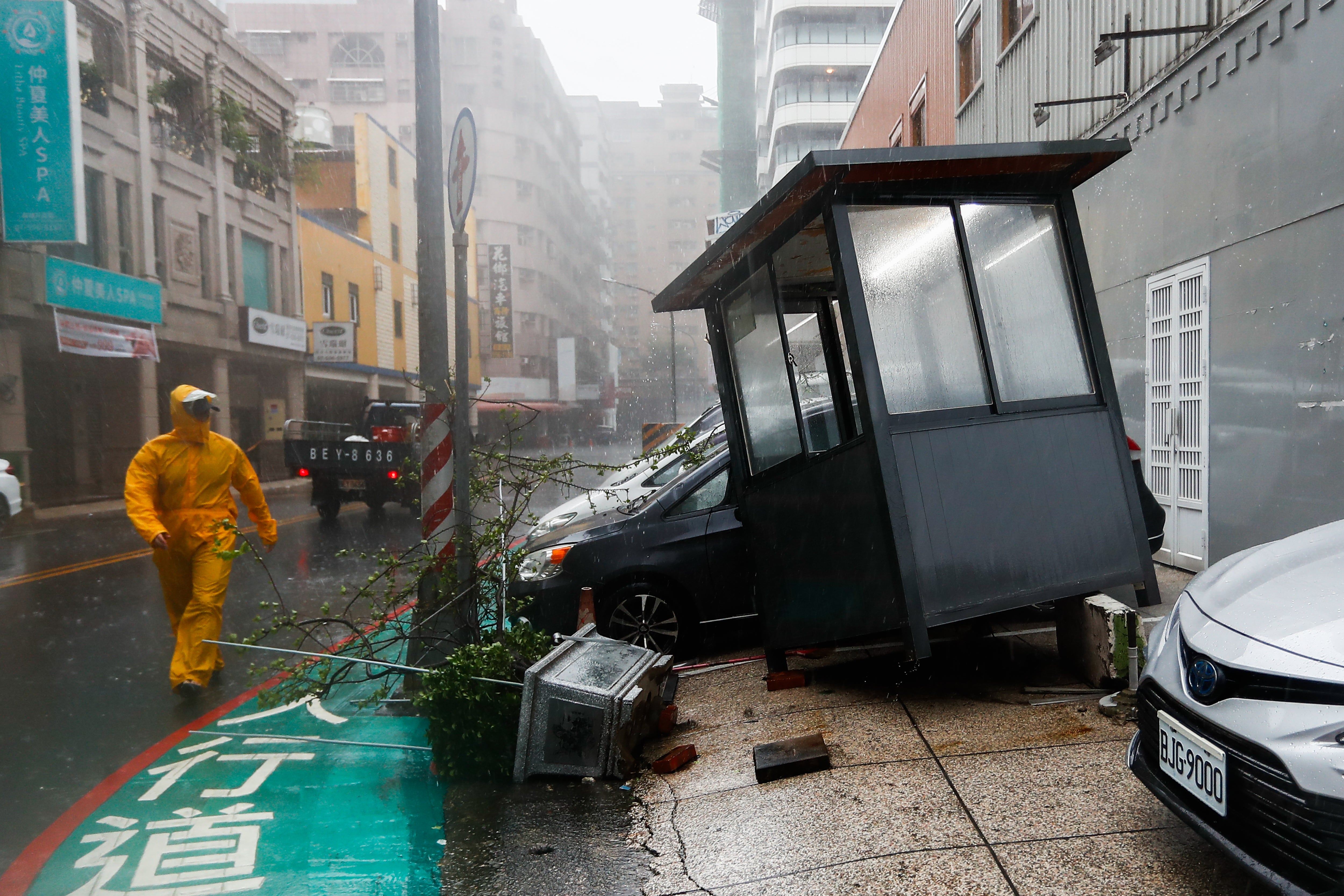Typhoon Krathon: Two killed, tens of thousands without power as ‘weird’ storm makes landfall in Taiwan
The storm, initially a Category 4 typhoon, weakened before making landfall but caused widespread damage and brought the entire island to a standstill for two days
Your support helps us to tell the story
Our mission is to deliver unbiased, fact-based reporting that holds power to account and exposes the truth.
Whether $5 or $50, every contribution counts.
Support us to deliver journalism without an agenda.

Louise Thomas
Editor
Typhoon Krathon slammed into southwestern Taiwan on Thursday, cutting power to tens of thousands of homes, flooding streets, and killing two people in the east.
The storm, initially a Category 4 typhoon, significantly weakened before making landfall near Kaohsiung, Taiwan’s major port city, causing widespread damage and bringing the entire island to a standstill for two days.
Krathon was labelled a “weird” storm by the local media as it lingered near Taiwan’s coast for a long time, moving unusually slowly and making landfall on the populated western coast of the island, generally considered safe from typhoons.
Schools, offices and shops were shut and flights were cancelled for the second day on Thursday as the typhoon began landfall around noon local time (4am GMT). This was the second time this year a storm shut down Taiwan’s stock exchange for two days.
All domestic flights were cancelled for a second day as well as 242 international ones. The north-south high-speed rail line suspended services between central and southern regions until at least early evening.

On Thursday morning, Kaohsiung residents woke up to emergency alerts to take shelter as the eye of the typhoon entered the region bringing gusts of over 160 kmph. Heavy rainfall, which continued to lash the region since this week, intensified.
At least two people were killed in the island’s east amid the extreme weather caused by the typhoon. One victim fell while trimming a tree and the other died when a vehicle was hit by a rock. Earlier this week, the storm killed two people in the Philippines and left thousands displaced.
No major casualties were reported in Kaohsiung, where the last major storm was Typhoon Thelma almost three decades ago.
“Fortunately people were well prepared this time,” Chou Yi-tang, a government official in Siaogang district, home to Kaohsiung’s airport, told Reuters news agency.
“It’s been a long time since such a big storm made landfall here,” he said.

Ahead of the storm’s landfall, the government distributed thousands of sandbags, water pumps were deployed and around 38,000 troops from the Taiwanese military were put on standby to assist with disaster relief efforts.
Approximately 10,000 people were evacuated from vulnerable areas, particularly from Kaohsiung and other high-risk regions such as Pingtung and Taitung.
“This is one of the most powerful storms we’ve seen hit the west coast in recent memory. We urge all residents to stay sheltered and be prepared for extensive rainfall,” Kaohsiung mayor Chen Chi-mai said on Tuesday.
Despite the preparations, the storm left many areas inundated in knee-deep water. On Thursday, at least 51,000 households remained without power primarily in Kaohsiung and Pingtung County, down from over 170,000 earlier.
Some eastern regions received more than 1.6m (5.2ft) of rain, washing cascades of rocks and mud on to roads.
The Southern Taiwan Science Park, site of one of the main factories of chipmaker TSMC, said operations were normal.
Amid the extreme weather, a fire at a hospital in southern Taiwan killed at least nine people in Pingtung county, which has been hit hard by Typhoon Krathon.
Reports said 176 patients were rushed to the front entrance and transferred to ambulances in the pouring rain. They were moved to shelters nearby.

Taiwan’s Central Weather Agency (CWA) said some eastern and southern parts of Taiwan are still set to see more extremely heavy rain, with up to 40cm (1.3ft) falling over the next 24 hours. It issued alerts for more rainfall which was expected to last until Friday morning.
Although the storm was expected to dissipate, the system is forecast to slowly work its way up Taiwan’s flat western plain and reach the capital Taipei, which could experience residual effects.
The slow movement of storms is becoming a troubling trend in recent years as it leads to longer periods of rainfall and more destruction. Scientists have earlier linked this kind of pattern to the climate crisis.
Rising global temperatures are heating ocean surfaces, providing more energy to the atmosphere and supercharging storms. These intensified storms carry more moisture and, combined with weakened atmospheric steering currents like jet streams, they are moving more slowly.
This stalling effect leads to extended periods of heavy rainfall and destructive winds, as seen with Krathon again.

Join our commenting forum
Join thought-provoking conversations, follow other Independent readers and see their replies
Comments